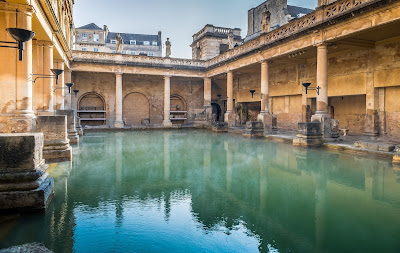When the Roman Legion arrived here in A.D. 43 they immediately recognized the significance of the site. After a regional revolt was forcefully put down in A.D. 60, the Romans began to turn the natural springs into spectacular sacred baths. The hot springs had to be controlled so Roman engineers began the placement of oak piles driven deep into the mud while lead pipes directed the sacred water into a 6-foot (2-meter) deep lead sheet-lined reservoir. Bathers would enter the sacred water by four steep steps that surrounded the entire bath.
The sacred water that still flow into the baths today once fell as rain in a nearby region known as Mendip Hills hundreds or even thousands of years ago. Slowly it percolated down through the layers of limestone to a depth of over 3 miles (5 km) where the Earth's natural heat warms the water to between 147 and 205 degrees Fahrenheit (64 and 96 degrees Celsius).
The water is colorless, but what is seen today at the baths is very green because of the algae growth that is stimulated by the heat and sunshine. Water from the baths is not recommended for drinking or bathing since it still flows through the lead pipes laid down so many years ago by the Romans.





0 comments:
Post a Comment